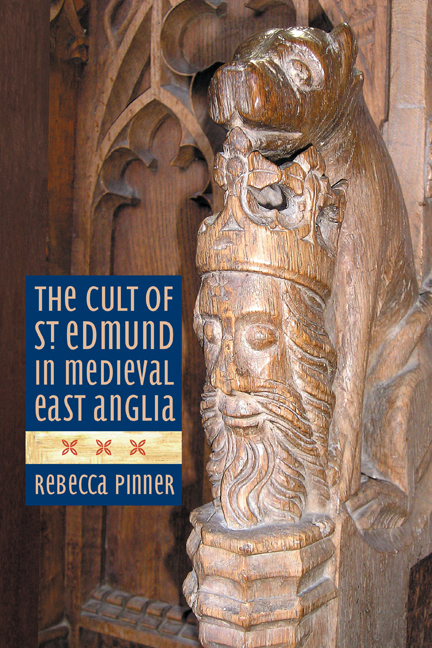Book contents
- Frontmatter
- Contents
- List of Illustrations
- Acknowledgements
- Abbreviations
- Introduction
- Part I Texts and Contexts: the Legend of St Edmund
- Part II Relics, Shrines and Pilgrimage: Encountering St Edmund at Bury
- Part III Beyond Bury: Dissemination and Appropriation
- Conclusion: ‘Martir, Mayde and Kynge’, and More
- Appendix 1 Synoptic Account of the Legend of St Edmund
- Appendix 2 Chronology of Significant Events and Texts Associated with the Cult of St Edmund
- Bibliography
- Index
Chapter 3 - Vita et Miracula
Published online by Cambridge University Press: 21 May 2021
- Frontmatter
- Contents
- List of Illustrations
- Acknowledgements
- Abbreviations
- Introduction
- Part I Texts and Contexts: the Legend of St Edmund
- Part II Relics, Shrines and Pilgrimage: Encountering St Edmund at Bury
- Part III Beyond Bury: Dissemination and Appropriation
- Conclusion: ‘Martir, Mayde and Kynge’, and More
- Appendix 1 Synoptic Account of the Legend of St Edmund
- Appendix 2 Chronology of Significant Events and Texts Associated with the Cult of St Edmund
- Bibliography
- Index
Summary
THE close relationship between Edmund's life and miracles is evinced by a number of manuscripts containing both texts.
London, British Library, MS Cotton Tiberius B. II
London, British Library, MS Cotton Tiberius B. ii is a high-status manuscript written by a single scribe at Bury St Edmunds in the last decade of the eleventh century. The version of the Passio in this manuscript is closely related to one of the abbreviated copies, now GI. Kgl. 1558. The manuscript also includes a copy of Herman's De Miraculis, suggesting that it was intended to be a comprehensive yet accessible account of Edmund's life and legend: his official biography. This is reiterated by an inscription in a fourteenth- or fifteenth-century hand which claims that the manuscript was kept in the close vicinity of the shrine: (‘liber feretrariorum sancti eadmundi’). The dating of the manuscript places it within the abbacy of Baldwin (1065–97), the rebuilder of the abbey church and staunch promoter of his abbey's saintly patron. In addition to attesting to the close relationship between the life and the miracle narratives, this manuscript therefore also indicates the multi-disciplinary nature of the cult of St Edmund and reiterates the necessity of considering it from a variety of perspectives.
New York, Pierpont Morgan Library, MS M. 736
This is equally true of New York, Pierpont Morgan Library, MS M.736. This manuscript marks a striking development in the elaboration of Edmund's cult at Bury. Dated c.1125–35, the manuscript may be securely attributed to Bury by the documents on the opening folios: fols 2–4 contain copies of two letters, the first from Henry I to Abbot Anselm of Bury (1121–48) forbidding him to continue a planned journey, and the second from the prior of Bury begging Anselm to return from Normandy in order to appease the king's displeasure. Following these on fols 3–4 are lists of pittances instituted by Anselm along with the names of the manors from which the money was to be derived. Furthermore, Elizabeth Parker McLachlan identifies the various hands as consistent with other manuscripts known to originate from Bury during this period.
- Type
- Chapter
- Information
- The Cult of St Edmund in Medieval East Anglia , pp. 63 - 74Publisher: Boydell & BrewerPrint publication year: 2015

